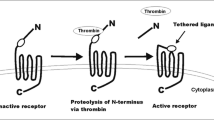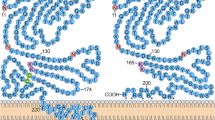Abstract
Thrombin-activatable fibrinolysis inhibitor (TAFI) is a basic carboxypeptidase zymogen present in blood plasma. Proteolytic activation of TAFI by thrombin, thrombin in complex with the endothelial cell cofactor thrombomodulin, or plasmin results in an enzyme (TAFIa) that removes carboxyl-terminal lysine residues from protein and peptide substrates, including cell-surface plasminogen receptors. TAFIa is therefore capable of inhibiting plasminogen activation in the pericellular milieu. Since plasminogen activation has been linked to angiogenesis, TAFIa could therefore have anti-angiogenic properties, and indeed TAFIa has been shown to inhibit endothelial tube formation in a fibrin matrix. In this study, the TAFI pathway was manipulated by providing exogenous TAFI or TAFIa or by adding a potent and specific inhibitor of TAFIa. We found that TAFIa elicited a series of anti-angiogenic responses by endothelial cells, including decreased endothelial cell proliferation, cell invasion, cell migration, tube formation, and collagen degradation. Moreover, TAFIa decreased tube formation and proteolysis in endothelial cell culture grown alone and in co-culture with breast cancer cell lines. In accordance with these findings, inhibition of TAFIa increased secretion of matrix metalloprotease proenzymes by endothelial and breast cancer cells. Finally, treatment of endothelial cells with TAFIa significantly inhibited plasminogen activation. Taken together our results suggest a novel role for TAFI in inhibiting tumour angiogenic behaviors in breast cancer.








Similar content being viewed by others
Abbreviations
- BME:
-
Basement membrane extract
- CM:
-
Conditioned media
- ε-ACA:
-
ε-aminocaproic acid
- ECM:
-
Extracellular matrix
- HUVECs:
-
Human umbilical vein endothelial cells
- MMPs:
-
Matrix metalloproteinases
- PAS:
-
Plasminogen activation system
- PTCI:
-
Potato tuber carboxypeptidase inhibitor
- TAFI:
-
Thrombin-activatable fibrinolysis inhibitor
- TAFIa:
-
Activated thrombin-activatable fibrinolysis inhibitor
- TM:
-
Thrombomodulin
- tPA:
-
Tissue-type plasminogen activator
- uPA:
-
Urokinase plasminogen activator
- uPAR:
-
Urokinase plasminogen activator receptor
- VEGF:
-
Vascular endothelial growth factor
References
Hanahan D, Weinberg RA (2000) The hallmarks of cancer. Cell 100(1):57–70
Hanahan D, Weinberg RA (2011) Hallmarks of cancer: the next generation. Cell 144(5):646–674. doi:10.1016/j.cell.2011.02.013
Bergers G, Benjamin LE (2003) Tumorigenesis and the angiogenic switch. Nat Rev Cancer 3(6):401–410. doi:10.1038/nrc1093
Folkman J (1995) Angiogenesis in cancer, vascular, rheumatoid and other disease. Nat Med 1(1):27–31
Folkman J (1971) Tumor angiogenesis: therapeutic implications. N Engl J Med 285(21):1182–1186. doi:10.1056/NEJM197111182852108
Gimbrone MA Jr, Leapman SB, Cotran RS, Folkman J (1972) Tumor dormancy in vivo by prevention of neovascularization. J Exp Med 136(2):261–276
Talmadge JE, Fidler IJ (2010) AACR centennial series: the biology of cancer metastasis: historical perspective. Cancer Res 70(14):5649–5669. doi:10.1158/0008-5472.CAN-10-1040
Zetter BR (1998) Angiogenesis and tumor metastasis. Annu Rev Med 49:407–424. doi:10.1146/annurev.med.49.1.407
Oh CW, Hoover-Plow J, Plow EF (2003) The role of plasminogen in angiogenesis in vivo. J Thromb Haemost 1(8):1683–1687
Andreasen PA, Egelund R, Petersen HH (2000) The plasminogen activation system in tumor growth, invasion, and metastasis. Cell Mol Life Sci 57(1):25–40. doi:10.1007/s000180050497
Law RH, Abu-Ssaydeh D, Whisstock JC (2013) New insights into the structure and function of the plasminogen/plasmin system. Curr Opin Struct Biol 23(6):836–841. doi:10.1016/j.sbi.2013.10.006
Ceruti P, Principe M, Capello M, Cappello P, Novelli F (2013) Three are better than one: plasminogen receptors as cancer theranostic targets. Exp Hematol Oncol 2(1):1–11. doi:10.1186/2162-3619-2-12
Pepper MS (2001) Role of the matrix metalloproteinase and plasminogen activator-plasmin systems in angiogenesis. Arterioscler Thromb Vasc Biol 21(7):1104–1117
Rakic JM, Maillard C, Jost M, Bajou K, Masson V, Devy L, Lambert V, Foidart JM, Noel A (2003) Role of plasminogen activator-plasmin system in tumor angiogenesis. Cell Mol Life Sci 60(3):463–473
Boffa MB, Koschinsky ML (2007) Curiouser and curiouser: recent advances in measurement of thrombin-activatable fibrinolysis inhibitor (TAFI) and in understanding its molecular genetics, gene regulation, and biological roles. Clin Biochem 40(7):431–442. doi:10.1016/j.clinbiochem.2006.10.020
Redlitz A, Tan AK, Eaton DL, Plow EF (1995) Plasma carboxypeptidases as regulators of the plasminogen system. J Clin Invest 96(5):2534–2538. doi:10.1172/JCI118315
Bazzi ZA, Lanoue D, El-Youssef M, Romagnuolo R, Tubman J, Cavallo-Medved D, Porter LA, Boffa MB (2016) Activated thrombin-activatable fibrinolysis inhibitor (TAFIa) attenuates breast cancer cell metastatic behaviors through inhibition of plasminogen activation and extracellular proteolysis. BMC Cancer 16(1):328. doi:10.1186/s12885-016-2359-1
Higuchi T, Nakamura T, Kakutani H, Ishi H (2009) Thrombomodulin suppresses invasiveness of HT1080 tumor cells by reducing plasminogen activation on the cell surface through activation of thrombin-activatable fibrinolysis inhibitor. Biol Pharm Bull 32(2):179–185
Reijerkerk A, Meijers JC, Havik SR, Bouma BN, Voest EE, Gebbink MF (2004) Tumor growth and metastasis are not affected in thrombin-activatable fibrinolysis inhibitor-deficient mice. J Thromb Haemost 2(5):769–779. doi:10.1111/j.1538-7836.2004.00682.x
Atkinson JM, Pullen N, Johnson TS (2013) An inhibitor of thrombin activated fibrinolysis inhibitor (TAFI) can reduce extracellular matrix accumulation in an in vitro model of glucose induced ECM expansion. Matrix Biol 32(5):277–287. doi:10.1016/j.matbio.2013.01.006
Guimaraes AHC, Laurens N, Weijers EM, Koolwijk P, van Hinsbergh VWM, Rijken DC (2007) TAFI and pancreatic carboxypeptidase B modulate in vitro capillary tube formation by human microvascular endothelial cells. Arterioscl Throm Vas 27 (10):2157–2162. doi:10.1161/Atvbaha.107.150144
Chazaud B, Ricoux R, Christov C, Plonquet A, Gherardi RK, Barlovatz-Meimon G (2002) Promigratory effect of plasminogen activator inhibitor-1 on invasive breast cancer cell populations. Am J Pathol 160(1):237–246. doi:10.1016/S0002-9440(10)64367-2
Grant DS, Lelkes PL, Fukuda K, Kleinman HK (1991) Intracellular mechanisms involved in basement-membrane induced blood-vessel differentiation invitro. In Vitro Cell Dev B 27 (4):327–336
Kubota Y, Kleinman HK, Martin GR, Lawley TJ (1988) Role of laminin and basement-membrane in the morphological-differentiation of human-endothelial cells into capillary-like structures. J Cell Biol 107(4):1589–1598. DOI:10.1083/jcb.107.4.1589
Sameni M, Dosescu J, Moin K, Sloane BF (2003) Functional imaging of proteolysis: stromal and inflammatory cells increase tumor proteolysis. Mol Imaging 2(3):159–175
Sloane BF, Sameni M, Podgorski I, Cavallo-Medved D, Moin K (2006) Functional imaging of tumor proteolysis. Annu Rev Pharmacol Toxicol 46:301–315. doi:10.1146/annurev.pharmtox.45.120403.095853
Sameni M, Cavallo-Medved D, Dosescu J, Jedeszko C, Moin K, Mullins SR, Olive MB, Rudy D, Sloane BF (2009) Imaging and quantifying the dynamics of tumor-associated proteolysis. Clin Exp Metastasis 26(4):299–309. doi:10.1007/s10585-008-9218-7
Romagnuolo R, Marcovina SM, Boffa MB, Koschinsky ML (2014) Inhibition of plasminogen activation by apo(a): role of carboxyl-terminal lysines and identification of inhibitory domains in apo(a). J Lipid Res 55(4):625–634. doi:10.1194/jlr.M036566
Deutsch DG, Mertz ET (1970) Plasminogen: purification from human plasma by affinity chromatography. Science 170(3962):1095–1096. doi:10.1126/science.170.3962.1095
Mohamed MM, Cavallo-Medved D, Rudy D, Anbalagan A, Moin K, Sloane BF (2010) Interleukin-6 increases expression and secretion of cathepsin B by breast tumor-associated monocytes. Cell Physiol Biochem 25(2–3):315–324. doi:10.1159/000276564
Hanahan D, Folkman J (1996) Patterns and emerging mechanisms of the angiogenic switch during tumorigenesis. Cell 86(3):353–364
Staton CA, Stribbling SM, Tazzyman S, Hughes R, Brown NJ, Lewis CE (2004) Current methods for assaying angiogenesis in vitro and in vivo. Int J Exp Pathol 85(5):233–248. doi:10.1111/j.0959-9673.2004.00396.x
Kessenbrock K, Plaks V, Werb Z (2010) Matrix metalloproteinases: regulators of the tumor microenvironment. Cell 141(1):52–67. doi:10.1016/j.cell.2010.03.015
Ulisse S, Baldini E, Sorrenti S, D’Armiento M (2009) The urokinase plasminogen activator system: a target for anti-cancer therapy. Curr Cancer Drug Targets 9(1):32–71
Pepper MS, Vassalli JD, Montesano R, Orci L (1987) Urokinase-type plasminogen activator is induced in migrating capillary endothelial cells. J Cell Biol 105(6 Pt 1):2535–2541
Pepper MS, Montesano R, Orci L, Vassalli JD (1991) Plasminogen activator inhibitor-1 is induced in microvascular endothelial cells by a chondrocyte-derived transforming growth factor-beta. Biochem Biophys Res Commun 176(2):633–638
Cavallo-Medved D, Rudy D, Blum G, Bogyo M, Caglic D, Sloane BF (2009) Live-cell imaging demonstrates extracellular matrix degradation in association with active cathepsin B in caveolae of endothelial cells during tube formation. Exp Cell Res 315(7):1234–1246. doi:10.1016/j.yexcr.2009.01.021
Redlitz A, Tan AK, Eaton DL, Plow EF (1995) Plasma carboxypeptidases as regulators of the plasminogen system. J Clin Invest 96(5):2534. doi:10.1172/jci118315
Swaisgood CM, Schmitt D, Eaton D, Plow EF (2002) In vivo regulation of plasminogen function by plasma carboxypeptidase B. J Clin Invest 110(9):1275–1282. doi:10.1172/jci0215082
Okumura N, Koh T, Hasebe Y, Seki T, Ariga T (2009) A novel function of thrombin-activatable fibrinolysis inhibitor during rat liver regeneration and in growth-promoted hepatocytes in primary culture. J Biol Chem 284(24):16553–16561. doi:10.1074/jbc.M109.011452
LeBleu VS, Macdonald B, Kalluri R (2007) Structure and function of basement membranes. Exp Biol Med 232(9):1121–1129. doi:10.3181/0703-MR-72
Itoh T, Tanioka M, Yoshida H, Yoshioka T, Nishimoto H, Itohara S (1998) Reduced angiogenesis and tumor progression in gelatinase A-deficient mice. Cancer Res 58(5):1048–1051
Egeblad M, Werb Z (2002) New functions for the matrix metalloproteinases in cancer progression. Nat Rev Cancer 2(3):161–174. doi:10.1038/nrc745
Hollborn M, Stathopoulos C, Steffen A, Wiedemann P, Kohen L, Bringmann A (2007) Positive feedback regulation between MMP-9 and VEGF in human RPE cells. Invest Ophthalmol Vis Sci 48(9):4360–4367. doi:10.1167/iovs.06-1234
Toth M, Sohail A, Fridman R (2012) Assessment of gelatinases (MMP-2 and MMP-9) by gelatin zymography. Methods Mol Biol 878:121–135. doi:10.1007/978-1-61779-854-2_8
van Hinsbergh VW, Engelse MA, Quax PH (2006) Pericellular proteases in angiogenesis and vasculogenesis. Arterioscler Thromb Vasc Biol 26(4):716–728. doi:10.1161/01.ATV.0000209518.58252.17
Lamalice L, Le Boeuf F, Huot J (2007) Endothelial cell migration during angiogenesis. Circ Res 100(6):782–794. doi:10.1161/01.RES.0000259593.07661.1e
van Hinsbergh VW, Koolwijk P (2008) Endothelial sprouting and angiogenesis: matrix metalloproteinases in the lead. Cardiovasc Res 78(2):203–212. doi:10.1093/cvr/cvm102
Sameni M, Dosescu J, Moin K, Sloane BF (2003) Functional imaging of proteolysis: stromal and inflammatory cells increase tumor proteolysis. Mol Imaging. doi:10.1162/153535003322556903
Sameni M, Moin K, Sloane BF (2000) Imaging proteolysis by living human breast cancer cells. Neoplasia. doi:10.1038/sj.neo.7900116
Sameni M, Dosescu J, Sloane BF (2001) Imaging proteolysis by living human glioma cells. Biol Chem 382(5):785–788. doi:10.1515/bchm.2001.382.5.785
Deryugina EI, Quigley JP (2012) Cell surface remodeling by plasmin: a new function for an old enzyme. J Biomed Biotechnol. doi:10.1155/2012/564259
Everts V, van der Zee E, Creemers L, Beertsen W (1996) Phagocytosis and intracellular digestion of collagen, its role in turnover and remodelling. Histochem J 28(4):229–245
Grove AD, Prabhu VV, Young BL, Lee FC, Kulpa V, Munson PJ, Kohn EC (2002) Both protein activation and gene expression are involved in early vascular tube formation in vitro. Clin Cancer Res 8(9):3019–3026
Schnaper HW, Barnathan ES, Mazar A, Maheshwari S, Ellis S, Cortez SL, Baricos WH, Kleinman HK (1995) Plasminogen activators augment endothelial cell organization in vitro by two distinct pathways. J Cell Physiol 165(1):107–118. doi:10.1002/jcp.1041650114
Franses JW, Edelman ER (2011) The evolution of endothelial regulatory paradigms in cancer biology and vascular repair. Cancer Res 71(24):7339–7344. doi:10.1158/0008-5472.CAN-11-1718
Wu C, Kim PY, Swystun LL, Liaw PC, Weitz JI (2016) Activation of protein C and thrombin activable fibrinolysis inhibitor on cultured human endothelial cells. J Thromb Haemost 14(2):366–374. doi:10.1111/jth.13222
Kim SJ, Shiba E, Ishii H, Inoue T, Taguchi T, Tanji Y, Kimoto Y, Izukura M, Takai S (1997) Thrombomodulin is a new biological and prognostic marker for breast cancer: an immunohistochemical study. Anticancer Res 17(3c):2319–2323
Acknowledgements
This work was funded by a Seeds4Hope grant from the Windsor Essex Cancer Centre Foundation.
Author information
Authors and Affiliations
Corresponding author
Additional information
Zainab A. Bazzi and Jennifer Balun have contributed equally to this work.
Electronic supplementary material
Below is the link to the electronic supplementary material.
Rights and permissions
About this article
Cite this article
Bazzi, Z.A., Balun, J., Cavallo-Medved, D. et al. Activated thrombin-activatable fibrinolysis inhibitor attenuates the angiogenic potential of endothelial cells: potential relevance to the breast tumour microenvironment. Clin Exp Metastasis 34, 155–169 (2017). https://doi.org/10.1007/s10585-017-9837-y
Received:
Accepted:
Published:
Issue Date:
DOI: https://doi.org/10.1007/s10585-017-9837-y




